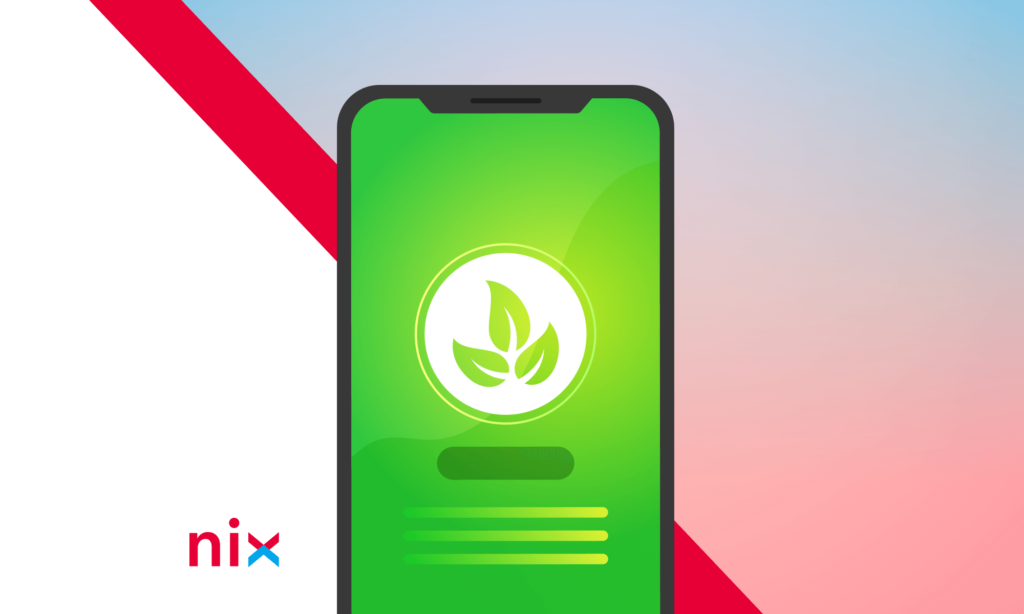Incorporating environmentally friendly practices into mobile app development has numerous long-term benefits for businesses, society, and the environment. Sustainable app development produces fewer CO2 emissions and offers clients more efficient and competitive IT solutions, ultimately enhancing the overall user experience. In this article, NIX mobile development expert, Jane Bondar will explore some of the most common sustainable app development practices.

Understanding Sustainable Technology
Sustainable technology is software that aligns with user needs and values while minimizing carbon emissions. Investing in sustainable apps can not only align with corporate social responsibility goals but also foster brand loyalty among environmentally conscious consumers. By adopting sustainable app development practices, businesses can reduce their carbon footprint and contribute to a greener future.
Sustainable applications are a relatively new trend that has been ignored for many years. Unlike traditional perceptions, software, not just physical devices, can significantly impact energy consumption. But nothing happens in a vacuum: the demand for software mainly dictates hardware development. In addition, unoptimized code leads to the work of useless devices and, as a result, unnecessary carbon emissions. Software developed without considering the requirements for energy conservation can be a real problem for the environment.
Currently, the demand for sustainable apps is on the rise, driven by consumers’ growing awareness of environmental issues. The Green Software Foundation proposes three key strategies to reduce software’s carbon footprint:
- Energy Efficiency: Minimizing electricity consumption by optimizing code and using efficient hardware.
- Efficient Equipment: Utilizing energy-efficient servers and low-power equipment.
- Clean Energy Utilization: Prioritizing software operations during periods when electricity is generated with limited greenhouse gas emissions or minimal pollution.
These principles are not dependent on specific technology stacks and are applicable across different stacks. You can learn more about how this principle works and allows you to develop greener software on the Green Software Foundation’s website.
Sustainable Approaches in Mobile App Development
To develop sustainable applications, you must reduce unnecessary operations, visual effects, API calls, etc. While the smartphone operating system performs some optimization, developers bear the bulk of the responsibilities. Unfortunately, there is no universal method for making a solution energy efficient. Developing sustainable apps requires a tailored approach, considering specific requirements, goals, and needs to maintain usability, flexibility, and maintainability.
Through continuous optimization and innovation, developers can create sustainable apps that prioritize performance and environmental responsibility. In this article, we’ll examine some of the most common practices in developing sustainable apps.
Optimize Location Tracking
When developing sustainable apps, every mobile app developer knows that location tracking is one of the most battery-consuming functions. In this case, the smartphone constantly searches for and receives signals from satellites, Wi-Fi access points, and cell towers, subsequently processing this data. It is not only about the device’s battery but also about the large amount of traffic and data stored and processed in the cloud. There are many business cases where you need to track a user’s location, but each has its own needs in terms of refresh rate and location accuracy. Using them as a potential for optimizing such resource-intensive operations is crucial.
Often, product owners request constant user location tracking from the development team. In such a situation, the appropriate response would be to inquire: “Why is this functionality needed?”. Often, the justification might revolve around determining if a user is near a specific store or when they leave the office. However, continuous tracking is usually unnecessary. Mobile platforms have a special geofencing feature optimized at the hardware level, triggering the app only when the user enters/leaves a particular location.
Customizing location tracking and resource usage extends beyond geofencing in sustainable apps. Developers should explore various options for each business case, including reducing location accuracy, subscribing solely to significant location changes, or tracking location under specific conditions (e.g., only when the phone is in motion). This approach enables a balance between energy efficiency and business objectives.
Optimize Networking
Networking operations are another energy-intensive aspect of app development. It is due to the network hardware that must remain active for some time after operations are completed. This is how the battery is drained.
Thus, you should consider the following power consumption aspects when developing sustainable apps:
- Cellular networks consume more power than Wi-Fi.
- Weak signals can result in data retransmission.
- Limited bandwidth prolongs receiver activity.
- The user’s location and service provider can influence energy consumption.
Effective networking in sustainable applications can extend battery life.
You can employ several strategies to optimize networking. The first—minimization—helps eliminate unnecessary traffic by assessing business requirements and system design. Examples include caching, compression of transmitted data, and reducing media quality and file size. Video conferencing software that dynamically adjusts the streaming quality is an example of this approach.
Grouping transactions is another strategy worth considering. Downloading content gradually keeps radio modules active, leading to energy consumption. Therefore, whenever possible, your app should group network operations. For example, when an app displays ads, downloading multiple ads simultaneously can reduce energy usage.
Postponing operations is another optimization strategy when it comes to sustainable apps. This is where scheduling deferrable network operations, a unique functionality in iOS, comes in handy. Such operations are performed outside the process, enhancing app responsiveness without constant running. In addition, the system can automatically optimize the call of such operations (for example, run it later, waiting for a good connection). This can be useful for backup or synchronization functions.
Lastly, it is advisable to limit network activity when using mobile internet, particularly for traffic-intensive transactions. For example, refrain from downloading an entire library of full-size images over a cellular connection unless explicitly requested by the user. This conserves energy and prevents users from becoming frustrated due to wasted data.
Improper Use of Timers
Maintaining server energy efficiency requires minimizing downtime, although idle time on personal devices is inevitable. Developers must ensure that in sustainable applications, this idle state isn’t needlessly interrupted, as waking the system from standby mode consumes additional energy.
Using timers to schedule repetitive actions like synchronization, downloading content, or updating locations prompts the system to wake up, which leads to corresponding energy consumption that isn’t always consistent. Applications often use timers without any real need. Therefore, it is recommended that you reassess the necessity of timers for each product.
Consider adopting a different approach: prioritize trigger events instead of relying on fixed time intervals. This shift in perspective can enhance energy efficiency.
Design
If your app predominantly relies on standard design elements, you can worry less about unnecessary content updates. After all, system APIs are specifically designed to optimize energy efficiency. However, most real-world projects want to stand out and use attractive custom designs. To ensure energy efficiency, it is advisable to:
1. Render content only when it is actually visible (not covered by other views and not off-screen).
2. Minimize the use of transparency, particularly the blur effect. Or at least use it when the “background” of the view with transparency remains static.
3. Add dark mode. Although implementing dark mode in apps may seem trendy or aesthetically pleasing, dark mode serves a deeper purpose in conserving smartphone resources by reducing screen brightness.
Native or Cross-platform?
The decision between native and cross-platform development is determined by the project’s goals, requirements, and limitations, including cost, time constraints, and technology compatibility.
Native solutions typically offer better performance, responsiveness, and energy efficiency because they are specifically optimized for the target platform. It results in a smoother user experience and prolonged device battery life, aligning with sustainability goals. Conversely, cross-platform apps require more resources.
While this article provides a glimpse into sustainable app development practices, it’s just the beginning of a broader conversation. By embracing sustainable technology, businesses can contribute to a brighter future and enhance their products’ appeal and effectiveness. Let’s harness the power of sustainable apps to create a greener, more sustainable world.






